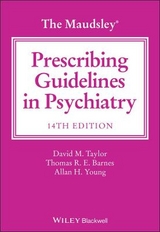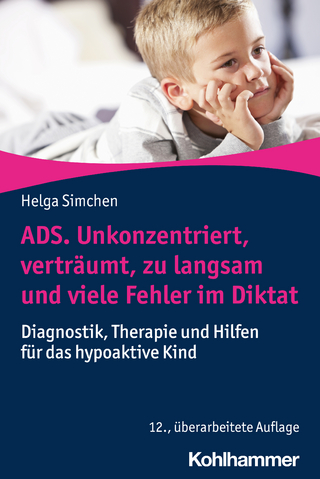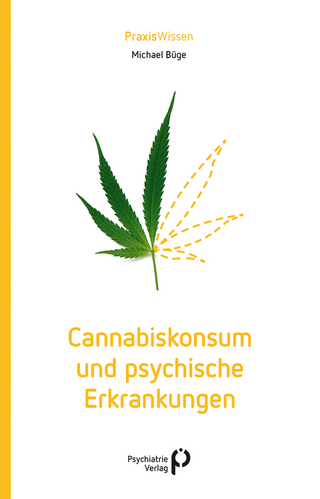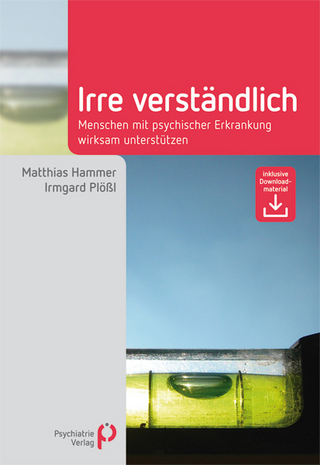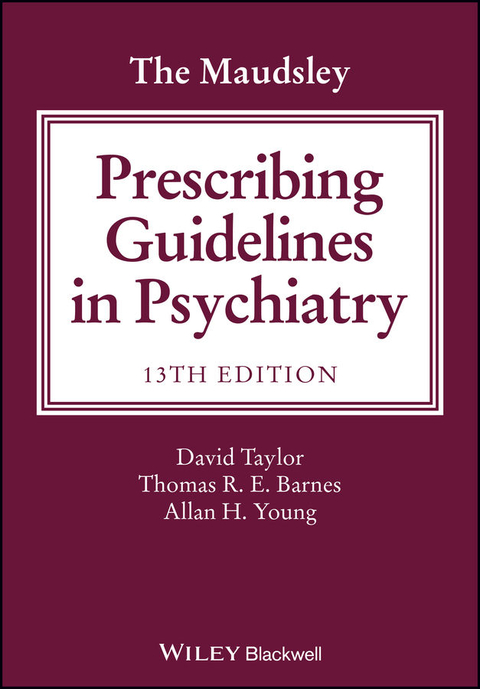
The Maudsley Prescribing Guidelines in Psychiatry
Wiley-Blackwell (Verlag)
978-1-119-44260-8 (ISBN)
- Titel ist leider vergriffen;
keine Neuauflage - Artikel merken
The revised and updated 13th edition of The Maudsley Prescribing Guidelines in Psychiatry provides up-to-date information, expert guidance on prescribing practice in mental health, including drug choice, treatment of adverse effects and how to augment or switch medications. The text covers a wide range of topics including pharmacological interventions for schizophrenia, bipolar disorder, depression and anxiety, and many other less common conditions. There is advice on prescribing in children and adolescents, in substance misuse and in special patient groups.
This world-renowned guide has been written in concise terms by an expert team of psychiatrists and specialist pharmacists. The Guidelines help with complex prescribing problems and include information on prescribing psychotropic medications outside their licensed indications as well as potential interactions with other medications and substances such as alcohol, tobacco and caffeine. In addition, each of the book's 165 sections features a full reference list so that evidence on which guidance is based can be readily accessed. This important text:
Is the world's leading clinical resource for evidence-based prescribing in day-to-day clinical practice and for formulating prescribing policy
Includes referenced information on topics such as transferring from one medication to another, prescribing psychotropic medications during pregnancy or breastfeeding, and treating patients with comorbid physical conditions, including impaired renal or hepatic function.
Presents guidance on complex clinical problems that may not be encountered routinely
Written for psychiatrists, neuropharmacologists, pharmacists and clinical psychologists as well as nurses and medical trainees, The Maudsley Prescribing Guidelines in Psychiatry are the established reference source for ensuring the safe and effective use of medications for patients presenting with mental health problems.
David M. Taylor BSc, MSc, PhD, FFRPS, FRPharmS, is Director of Pharmacy and Pathology at the Maudsley Hospital and Professor of Psychopharmacology at King's College, London. Thomas R. E. Barnes, MBBS, MD, FRCPsych, DSc, is Emeritus Professor of Clinical Psychiatry at Imperial College London and joint-head of the Prescribing Observatory for Mental Health at the Royal College of Psychiatrists' Centre for Quality Improvement. Allan H. Young, MB, ChB, MPhil, PhD, FRCPC, FRCPsych, is Chair of Mood Disorders and is Director of the Centre for Affective Disorders in the Department of Psychological Medicine in the Institute of Psychiatry at King's College London, UK.
Preface x
Acknowledgements xii
Notes on using The Maudsley Prescribing Guidelines in Psychiatry xiii
List of abbreviations xv
Part 1 Drug treatment of major psychiatric conditions 1
Chapter 1 Schizophrenia and related psychoses 3
ANTIPSYCHOTIC DRUGS 3
General introduction 3
General principles of prescribing 8
Minimum effective doses 9
Licensed maximum doses 12
Equivalent doses 14
High?dose antipsychotics: prescribing and monitoring 16
Combined antipsychotics 20
Antipsychotic prophylaxis 25
Negative symptoms 31
Monitoring 36
Relative adverse effects - a rough guide 39
Treatment algorithms for schizophrenia 40
First?generation antipsychotics - place in therapy 44
NICE guidelines for the treatment of schizophrenia 46
Antipsychotic response - to increase the dose, to switch, to add or just wait - what is the right move? 49
Acutely disturbed or violent behaviour 54
Antipsychotic depots/long?acting injections (LAIs) 66
Depot/LAI antipsychotics - pharmacokinetics 71
Management of patients on long?term depots/LAIs 73
Aripiprazole long?acting injection 75
Olanzapine long?acting injection 77
Paliperidone palmitate long?acting injection 79
Risperidone long?acting injection 82
Electroconvulsive therapy and psychosis 86
Omega?3 fatty acid (fish oils) in schizophrenia 88
ANTIPSYCHOTIC ADVERSE EFFECTS 90
Extrapyramidal symptoms 90
Akathisia 94
Weight gain 97
Treatment of antipsychotic?induced weight gain 99
Neuroleptic malignant syndrome 104
Catatonia 107
ECG changes - QT prolongation 112
Effect of antipsychotic medications on plasma lipids 119
Diabetes and impaired glucose tolerance 123
Blood pressure changes 130
Hyponatraemia 134
Hyperprolactinaemia 137
Sexual dysfunction 141
Pneumonia 148
Switching antipsychotics 150
Venous thromboembolism 153
REFRACTORY SCHIZOPHRENIA AND CLOZAPINE 156
Clozapine initiation schedule 156
Optimising clozapine treatment 158
Alternatives to clozapine 162
Re?starting clozapine after a break in treatment 169
Initiation of clozapine for community?based patients 170
CLOZAPINE ADVERSE EFFECTS 175
Clozapine: common adverse effects 175
Clozapine: uncommon or unusual adverse effects 179
Clozapine: serious haematological and cardiovascular adverse effects 184
Clozapine?induced hypersalivation 189
Clozapine?induced gastrointestinal hypomotility (CIGH) 193
Clozapine, neutropenia and lithium 197
Clozapine and chemotherapy 202
Chapter 2 Bipolar disorder 205
Lithium 205
Valproate 214
Carbamazepine 221
Antipsychotic drugs in bipolar disorder 226
Antipsychotic long?acting injections in bipolar disorder 229
Physical monitoring for people with bipolar disorder 232
Treatment of acute mania or hypomania 235
Rapid?cycling bipolar disorder 241
Bipolar depression 243
Prophylaxis in bipolar disorder 250
Chapter 3 Depression and anxiety disorders 255
Depression: introduction 255
Basic principles of prescribing in depression 255
Official guidance on the treatment of depression 256
Antidepressants: general overview 257
Recognised minimum effective doses of antidepressants 262
Drug treatment of depression 264
Treatment of refractory depression: first choice 267
Treatment of refractory depression: second choice 271
Treatment of refractory depression: other reported treatments 274
Psychotic depression 278
Electroconvulsive therapy and psychotropic drugs 281
Stimulants in depression 285
Post?stroke depression 290
Treatment of depression in the elderly 293
Antidepressants: alternative routes of administration 298
Antidepressant prophylaxis 306
Antidepressant discontinuation symptoms 310
Antidepressants: swapping and stopping 314
Drug interactions with antidepressants 321
Cardiac effects of antidepressants 325
Antidepressant?induced arrhythmia 329
Antidepressant?induced hyponatraemia 333
Antidepressants and hyperprolactinaemia 337
Antidepressants and diabetes mellitus 340
Antidepressants and sexual dysfunction 343
SSRIs and bleeding 347
St John's wort 355
Antidepressants: relative adverse effects - a rough guide 358
Anxiety spectrum disorders 360
Benzodiazepines in the treatment of psychiatric disorders 373
Benzodiazepines: dependence and detoxification 377
Benzodiazepines and disinhibition 381
Chapter 4 Addictions and substance misuse 385
Introduction 385
Alcohol dependence 387
Opioid dependence 405
Nicotine and smoking cessation 431
Pharmacological treatment of dependence on stimulants 439
GHB and GBL dependence 442
Benzodiazepine misuse 445
Synthetic cannabinoid receptor agonists (SCRAs) 447
Interactions between 'street drugs' and prescribed psychotropic drugs 450
Drugs of misuse - a summary 454
Part 2 Drug treatment of special patient groups 459
Chapter 5 Children and adolescents 461
Principles of prescribing practice in childhood and adolescence 461
Depression in children and adolescents 463
Bipolar illness in children and adolescents 471
Psychosis in children and adolescents 478
Anxiety disorders in children and adolescents 480
Obsessive compulsive disorder (OCD) in children and adolescents 485
Post?traumatic stress disorder in children and adolescents 491
Attention deficit hyperactivity disorder 496
Autism spectrum disorder 504
Tics and Tourette's syndrome 512
Melatonin in the treatment of insomnia in children and adolescents 517
Rapid tranquillisation (RT) in children and adolescents 521
Doses of commonly used psychotropic drugs in children and adolescents 524
Chapter 6 Prescribing in older people 525
General principles 525
Dementia 529
Safer prescribing for physical conditions in dementia 570
Management of behavioural and psychological symptoms of dementia 557
A guide to medication doses of commonly used psychotropic drugs in older adults 586
Covert administration of medicines within food and drink 593
Chapter 7 Pregnancy and breastfeeding 599
Drug choice in pregnancy 599
Breastfeeding 619
Chapter 8 Hepatic and renal impairment 635
Hepatic impairment 635
Renal impairment 645
Part 3 Prescribing in specialist conditions 661
Chapter 9 Drug treatment of other psychiatric conditions 663
Borderline personality disorder 663
Eating disorders 667
Delirium 672
Chapter 10 Drug treatment of psychiatric symptoms occurring in the context of other disorders 679
General principles of prescribing in human immunodeficiency virus (HIV) 679
Prescribing psychotropics in HIV 685
Epilepsy 688
22q11.2 Deletion syndrome 696
Learning disabilities 699
Huntington's disease 704
Multiple sclerosis 709
Parkinson's disease 715
Atrial fibrillation 719
Bariatric surgery 722
Part 4 Other aspects of psychotropic drug use 729
Chapter 11 Pharmacokinetics 731
Plasma level monitoring of psychotropic drugs 731
Interpreting post?mortem blood concentrations 742
Acting on clozapine plasma concentration results 744
Psychotropic drugs and cytochrome (CYP) function 746
Smoking and psychotropic drugs 750
Drug interactions with alcohol 753
Chapter 12 Other substances 759
Caffeine 759
Nicotine 765
Chapter 13 Psychotropic drugs in special conditions 769
Psychotropic drugs in overdose 769
Driving and psychotropic drugs 776
Psychotropic drugs and surgery 781
Chapter 14 Miscellany 787
Enhancing medication adherence 787
Re?starting psychotropic medications after a period of non?compliance 794
Biochemical and haematological effects of psychotropic medications 798
Summary of psychiatric adverse effects of non?psychotropic medications 808
Prescribing drugs outside their licensed indications ('off?label' prescribing) 813
The Mental Health Act in England and Wales 816
Site of administration of intramuscular injections 821
Index 825
| Erscheinungsdatum | 28.07.2018 |
|---|---|
| Reihe/Serie | The Maudsley Prescribing Guidelines Series |
| Verlagsort | Hoboken |
| Sprache | englisch |
| Maße | 171 x 245 mm |
| Gewicht | 1242 g |
| Einbandart | kartoniert |
| Themenwelt | Medizin / Pharmazie ► Medizinische Fachgebiete ► Psychiatrie / Psychotherapie |
| ISBN-10 | 1-119-44260-5 / 1119442605 |
| ISBN-13 | 978-1-119-44260-8 / 9781119442608 |
| Zustand | Neuware |
| Haben Sie eine Frage zum Produkt? |
aus dem Bereich
